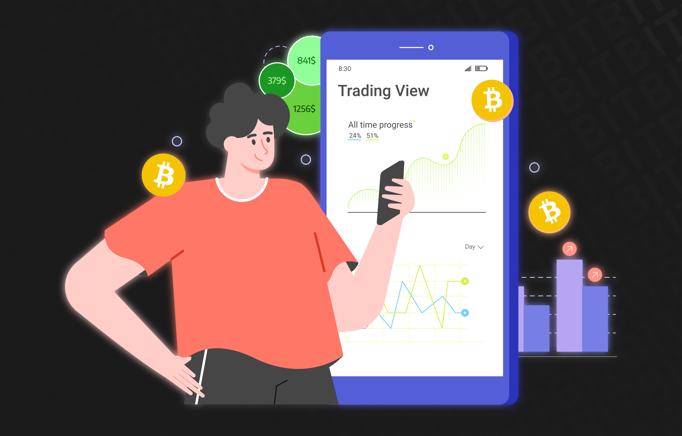Long-term Trading Methods
Kripto za napredne
Drugi članci
When you're playing the long-term game, you embody the virtue of patience amidst the wild volatility in the crypto realm. From dollar-cost averaging to lump sum investing, long-term trading methods in crypto have proven to be quite profitable over the last couple bullish years.
Typically, traders that incorporate long-run trading methods adopt disciplined strategies which realize periodically-consistent returns on their investments over multiple years, or enjoy significant gains after a considerable amount of time.
To generate profits, such strategies depend on fundamentals which drive the intrinsic value of an asset or a group of assets, such as ameliorating market conditions which a cryptocurrency calls home, or the technical price movement of a security, such as the price point of a cryptocurrency relative to its yearly range, which marks an attractive entry point for purchase.
It’s more appropriate to label these traders as investors, since their behavior is quite similar to those which invest in traditional financial assets like stocks or real estate. But just like short-term traders, long-run players are all about timing their moves at the most optimal moments to capitalize on the price swings of assets, or the slow & steady growth of an asset’s price.
The most utilized long-term trading methods in crypto are HODLing, staking, dollar-cost averaging and lump sum investing. While all these methods adopt similar perceptions on the market and aim for the unified goal of sweet profits, they differ slightly in approach.
Let’s explore each method in detail.
HODLing
You can’t call yourself a crypto investor if you haven’t HODLed any cryptocurrencies. Following a similar approach to hoarding, HODLing is all about purchasing a crypto asset and holding onto it for a period of time, which typically ranges from one to three years.
An acronym for “hold on for dear life”, HODLing has been heavily popularized among crypto traders and can be quite the effective strategy for novices which buy an asset (perhaps when it dips in value) and hold it in a wallet without doing anything, while enthusiasts will spend time researching the asset’s potential and will have strong reasoning to hold it.
For example, crypto enthusiast Maria spent hours on researching & analyzing Bitcoin to later find out that its price is undervalued. So, she purchases a few Bitcoins and hold on to them for as long as it takes, amidst the wild volatility of the market, before cashing out at the right time.
Staking

The process of staking is similar to HODLing in a sense that one would purchase crypto assets and hold them in a wallet, but what makes staking different is that such coins are pledged to their mother network, meaning that they’re used to validate transactions or finance the projects of the team behind the cryptocurrency.
Staking benefits are much like stock dividends, as those which engage in staking realize rewards in the form of additional coins or interest. As a simple example, Cardano employs a proof-of-stake (PoS) model which allows staking to take place, prompting traders to buy & hold ADA tokens and that generates passive income in yields which can surpass 10% on a yearly basis.
Dollar-cost Averaging
Que in some classical music. Dollar-cost averaging is a trading method which has been around for decades, long before cryptocurrencies were born. This method centers around the periodic investment of funds towards certain assets, regardless of the market sentiment or asset price.
The way dollar-cost averaging works is by the mechanism of recurrent, small investments averaging out any short-term peaks, troughs and volatility. Dollar-cost averaging is an appealing approach for crypto beginners and even the fanatics, as it doesn’t factor-in temporary price volatilities and doesn’t necessitate frequent monitoring.
One would regularly invest $1,000 for example in Ethereum every month, given its bright future prospects, and would then redeem the return on investment several years later.
Lump Sum Investing
This method does what it says on the tin. Instead of investing smaller sums of funds on a regular basis like one would do with dollar-cost averaging, lump sum investing entails the large investing of money in a specific asset in one go. In other words, you’re putting all the eggs in one basket.
Typically, lump sum investors seek to capture the troughs or lower price points of an asset, and inject a significant amount of capital to purchase this asset at very attractive prices. This is to generate significant returns, as good points of purchase are generally followed by price spikes which can generate hefty gains.
Lump sum investing is a doubtful advantage, However, lump sum investing would be the riskier method among the batch, since it comes with the imminent risk of price crashes or the mistiming of purchase.
Benefits of Long-term Trading
Like any other endeavor, long-term trading has its advantages and disadvantages:
- Diminishes the need for constantly keeping up with price action
- Generates consistent, periodic returns given a successful strategy
- Isn’t impacted by emotion-fueled decisions which can be impulsive
Drawbacks of Long-term Trading
- Not for the soft-hearted which can’t handle multiple market downturns
- Typically generates lower returns than short-term investments
- Can lead to hefty losses if no exit plans are put in place
Rules of Thumb
Before you embark on your investing journey, take these four rules to heart:
1- No Leverage
Incorporating leverage in your long-term trading strategy can result in catastrophes if the asset price plummets. It’s best advised to steer clear from leverage if you’re in for the long-run, as your investments will be succumbed to many ups & downs over the years; you don’t want to lose your capital after years of patience due to vicious bear market.
2- Don’t Trade on Emotions
Another rule is to not sweat the small stuff. Crypto markets are volatile, and cryptocurrencies go through rallies and crashes on a regular basis. If you can’t resist the temptation to cash-out when things aren’t going your way, long-term investing may not be for you. Remember: good things come to those who wait!
3- Diversification Won’t Hurt
Long-term investing approaches such as lump sum investing are all about putting your eggs in one basket, which may not be a great idea. Diversifying your funds across selected assets can protect your portfolio from inflation and market downturns, and thus secure long-term wealth.
Summary
In a nutshell, long-term trading methods are all about the incremental gains which traders/investors realize after exercising their strategies in a consistent & concise manner. Trading for the long-run can promise recurrent, periodic returns to the extent that it can be regarded as a way to generate passive income.
Yet, just like any other investment venture, long-term trading approaches come with associated risks, such as the possibility of losing capital due to misuse of leverage, impulsive decisions fueled by emotions, or simply adopting a weak strategy.
Before investing or trading in crypto, it’s always best advised to study the assets well which you would like to invest in, learn about the risks associated with such activities and implement exit plans along your journey if things don’t go the right way.
Explore the BITmarkets academy to learn more about the ever-so evolving world of crypto, and to stay up to date with the latest market revelations.


